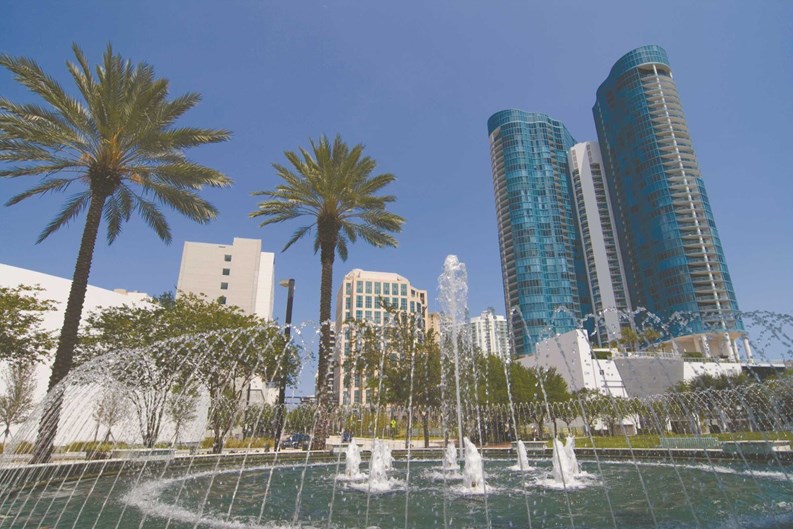Previously overshadowed by its neighbor—Miami—during the past few decades Fort Lauderdale has become a stand-alone destination. It's a major yachting center and resort area that has become a major port for cruise passengers. Despite the transients, Fort Lauderdale is a vibrant community that attracts people from all over the world who want to make this beach jewel their home.
Fort Lauderdale is named after a series of forts built during the Second Seminole War. The forts are named for Major William Lauderdale, the commander of the soldiers who built the first fort. However, development of the city did not begin until 50 years after the forts were abandoned.
History and Development
The area in which Fort Lauderdale would later be founded was inhabited for more than a thousand years by the Tequesta Indians. Contact with Spanish explorers in the 16th century proved disastrous for the Tequesta, as the Europeans brought diseases to which the Tequesta had no resistance. By 1763, there were only a few Tequesta left. Most were evacuated to Cuba when the Spanish ceded Florida to the British in 1763. Although control of the area changed between Spain, United Kingdom, the United States, and the Confederate States of America, it remained largely undeveloped until the 20th century.
Before the 20th century, the Fort Lauderdale area was known as the "New River Settlement." In the 1830s approximately 70 settlers lived along the New River. On January 6, 1836, William Cooley, the local Justice of the Peace, who traded with the Seminole Indians was killed by a band of Seminoles while he was salvaging a shipwreck The attackers also killed his wife, children and the children's tutor. The other farms in the settlement were not attacked, but the residents abandoned the settlement.
The first U.S. stockade named Fort Lauderdale was built in 1838, and was a site of fighting during the Second Seminole War. The fort was abandoned in 1842 and remained virtually unpopulated until the 1890s. It wasn't until Frank Stranahan arrived in the area in 1893 to operate the New River ferry; and the Florida East Coast Railroad's completion of a route through the area in 1896, that any organized development began. The city was incorporated in 1911, and in 1915 was designated the county seat of newly formed Broward County.
Fort Lauderdale's first major development began in the 1920s, during the Florida land boom of the 1920s. The 1926 Miami Hurricane and the Great Depression of the 1930s caused a great deal of economic dislocation. When World War II began, Fort Lauderdale became a major military base, with a Naval Air Station to train pilots, radar operators, and fire control operators. After the war ended, service members returned to the area, spurring an enormous population explosion which dwarfed the 1920s boom.
Annual average precipitation is 64.2 inches, most occurring during from May through October. The hurricane season is between June 1 and November 30 with major hurricanes most likely to affect the city in September and October. The most recent storms to directly affect the city were Hurricane Katrina and Hurricane Wilma, both of which struck the city in 2005.
Touristas and Students
Fort Lauderdale's economy is heavily reliant on tourism. From the 1940s through the 1980s, the city was known as a spring break destination for college students. Cruise ships and boating provide the tourism revenue base. Fort Lauderdale now attracts a more sophisticated and affluent tourist, while largely ignoring the dwindling college crowd. There is a convention center located west of the beach and southeast of downtown.
The downtown area, has seen development in the past decade, and now boasts many new hotels and high-rise condos. The downtown area is the largest in Broward County. Office buildings and high-rises include Las Olas River House, Las Olas Grand, 110 Tower, Bank of America Plaza, One Financial Plaza, Broward Financial Center, Barnett Bank Plaza, New River Center, One Corporate Center, SunTrust Centre, 101 Tower and SouthTrust Tower.
Fort Lauderdale is a major manufacturing and maintenance center for yachts. The boating industry provides more than 109,000 jobs in the county. With its many canals, and proximity to the Bahamas and Caribbean, it's also a popular yachting stop, and home to 42,000 boats, and approximately 100 marinas and boatyards. Additionally, the annual Fort Lauderdale International Boat Show, the third largest boat show in the world, brings over 125,000 people each year.
Like many parts of Florida, the population is seasonal, as snowbirds from the north escape the cold winter. The city is sometimes referred to as "Fort Liquordale" because of its beaches, bars, nightclubs, and history as a spring break location for tens of thousands of college students. The city has actively discouraged college students from visiting since the mid-1980s, passing strict laws aimed at preventing the mayhem that regularly occurred.
In recent decades, the city has become known for having a large gay community and a popular destination for LGBT tourists. Fort Lauderdale's arts and entertainment district, a.k.a, the Riverwalk Arts & Entertainment District, runs east-west along Las Olas Boulevard, from the beach to the heart of downtown.
Some interesting points of interest to check out include, the Stranahan House, the oldest building in Fort Lauderdale, originally built as a trading post. In addition to its museums, beaches, and nightlife, Fort Lauderdale is home to the Fort Lauderdale Swap Shop, an indoor/outdoor flea market and the site of the world's largest drive-in movie theater, with 13 screens. The International Swimming Hall of Fame is located on Fort Lauderdale beach, and houses a large aquatic complex, a museum, theater, and research library. Hugh Taylor Birch State Park is a 180-acre park along the beach, with nature trails, camping, picnicking areas, canoeing, and features the Terramar Visitor Center, with exhibits about the ecosystem of the park.
Fascinating history, energetic present and exciting future. No wonder why so many choose to make Fort Lauderdale their home...even if it is for just a few months a year.
Liam P. Cusack is associate editor of The South Florida Cooperator.







Leave a Comment